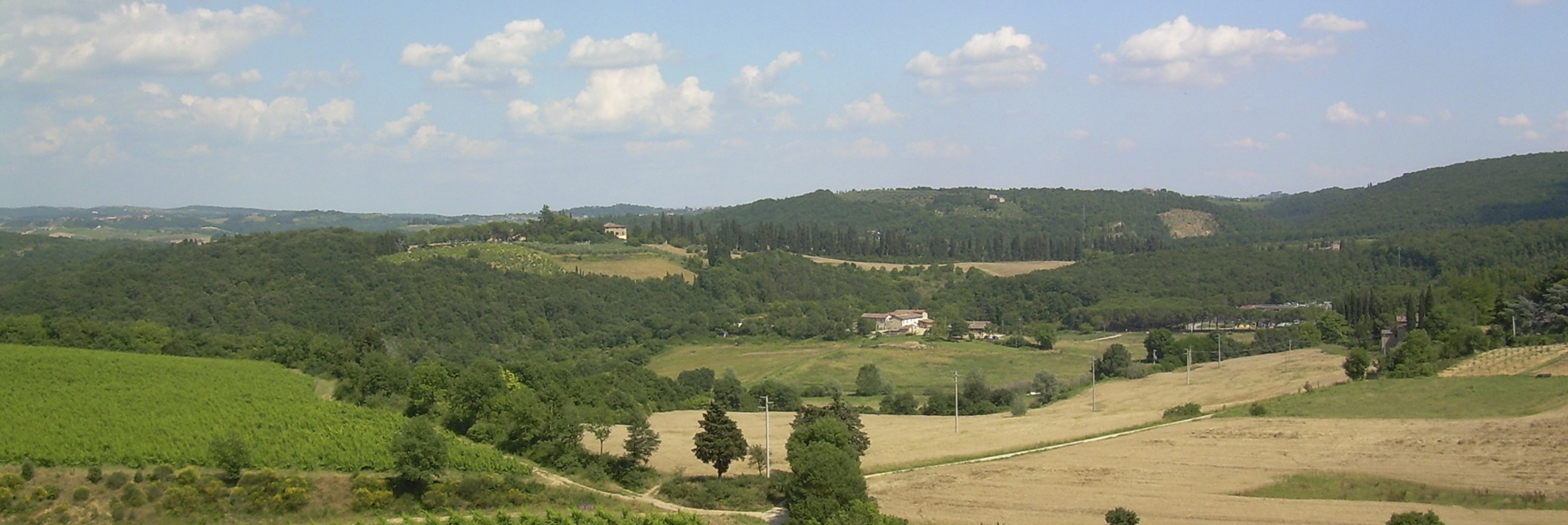Eclectic Beauty
Leaving Porta Pispini, we see the fourteenth-century walls that lead to Porta Ovile and the sixteenth-century bastion of Baldassare Peruzzi, military engineer and Sienese architect who left evidence of his work in Siena and other Italian cities.
Continuing we find Porta Ovile and the elegant railway station which remember Palazzo Pubblico in a contemporary key.
Towards the Sienese Chianti, the panorama opens into countryside. Siena is only a few kilometers away, you can still see it on the horizon behind some hills.
From here we can range over much of the territory of the province of Siena: to the west the gentle profile of the Montagnola Senese, further away the Poggio di Montieri and the Cornate di Gerfalco, to the south the Amiata, the poggio di Radicofani and Monte Cetona, to the west the nearby Chianti chain and further away the Pratomagno.
We meet the Certosa di Pontignano, a complex of eclectic beauty: the church, the rectory, the cloisters, the garden.
Then from Monteliscai, once a castle of the Sienese Republic, already mentioned in documents since 1101, towards the church of San Giorgio a Lapi, which stands high up. Near the church, a stretch of dirt road begins, the penultimate that professional cyclists travel, in the opposite direction, in the now famous “Strade Bianche” world tour race that starts and ends in Siena.
It is precisely along these last kilometers of dirt road that you can admire the agricultural landscape of the countryside near the city of Siena, so rich in tree-lined rows, of what remains of the old terraces and dry stone walls, which once delimited properties and roads, vineyards and olive groves that still alternate with more or less large wooded portions.
Crossed Areas
Many authors have written about Siena and its harmonious beauty throughout history, and it is difficult to invent new words to describe its charm, especially if you are not a poet. It was declared a UNESCO World Heritage Site in 1995.
José Saramago, a Portuguese writer and Nobel Prize winner, fell in love with the city and dedicated words to the town, describing it with brushstrokes of deep emotion and passion:
‘And here is Siena, the beloved, the city where my heart is truly pleased’. ‘The three hills on which it is built make it a town where there are no two identical roads, all of them are bound to no geometry. ‘This wonderful colour, the colour of the burnished body, is also the colour of the cornbread crust, this wonderful colour goes from stones to the road and roofs, softens the sunlight and wipes away anxieties and fears from your face.
‘There is nothing more beautiful than this town’. Piazza del Campo ‘a sloping and curved square like a shell that the builders did not want to pave and it remained so, as if it were a lap’.
‘I look at the old palaces of Siena, ancient houses where I want to live one day, with a window of my own, overlooking the coloured clay roof tiles, over the green shutters of the windows, as if in an attempt to decipher where this secret that Siena murmurs and that I will continue to hear, although I do not understand it, until the end of my life.
The Chianti countryside has become an icon for an almost ideal landscape: alternating hills covered with dense woods, rows of vines and some silver brushstrokes of olive groves. In the replicated design, the ‘farmhouses’, cottages with lodge and dovecotes peek over the top of hills and meandering dirt tracks, bordered by low walls and towering cypress trees. Imposing villas, castles, abbeys and parish churches, small villages inspired by centuries of people who lived in these places and made history.
From the Middle Ages to today this landscape, known and recognized throughout the world, has been shaped by humanity’s blood, sweat and tears, creating a place tailored to its needs, without squeezing or exploiting the earth, but indulging generosity and refining the production of its most precious fruits with skill and ingenuity: grapes and olives.
The resulting robust wines with a round and intense flavour, and a flavoured and sour oil that enhances the flavour of savoury dishes of a cuisine still rich in vegetable products, the courtyard and hunting dishes, as it has always taken place in the peasant tradition, being the creator of a still recognizable and unique culture rooted in this land.
